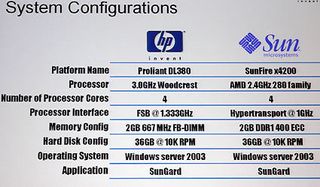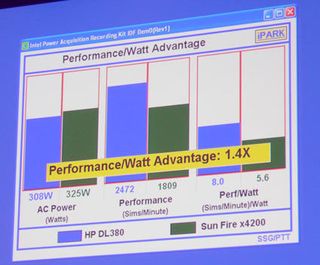IDF Spring 2006: Will Intel's Core Architecture Close the Technology Gap?
The Server Challenge

For the first time, Intel compared one of its upcoming server systems to an AMD-powered machine. Yes, you got it right; it actually mentioned the name of its competitor that has been taking away market shares for some time. We understand that the comparison was meant for the sole purpose of showing the tremendous advances and the dominance that Intel expects to have over AMD here, but we found it a little odd to compare a non-released, future product (Woodcrest) against a product that has been around for a while.
The system in question was HP's ProLiant DL380, which is under development and is going to use Xeon Woodcrest processors at around 3.0 GHz. The comparison system was a SunFire X4200 with Opteron 280s at 2.4 GHz. Intel used the risk assessment software SunGard, which certainly is a great application for showing computational power (not a chance for AMD here), but it does not reflect the memory subsystem very much, involving localized DDR400 memory controllers vs. Intel's centralized quad channel DDR2-533 engine and fully-buffered DIMMs.
FBD setups are known to suffer from latencies while, again, the Core micro architecture will certainly do its part to hide it. And again, we prefer to wait for final systems before judging.

This contest was not about performance only, it was about performance per watt. Here, Intel states an advantage of 1.4x over AMD.

From a technology point of view, the Bensley platform is certainly going to offer more than most competitors - whether you can make use of it or not.
Stay on the Cutting Edge
Join the experts who read Tom's Hardware for the inside track on enthusiast PC tech news — and have for over 25 years. We'll send breaking news and in-depth reviews of CPUs, GPUs, AI, maker hardware and more straight to your inbox.
Current page: The Server Challenge
Prev Page There Is More To Save Next Page Mashups To Drive MobilityMost Popular

